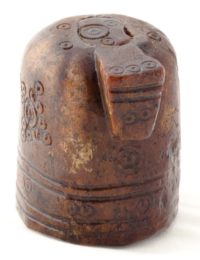 Archaeologists have unearthed a rare medieval chess piece in the remains of a 13th century house in Tønsberg, Norway. It was discovered just before Christmas by a team from the Norwegian Institute of Cultural Heritage Research (NIKU) who were excavating the Anders Madsens gate area of Tønsberg.
Archaeologists have unearthed a rare medieval chess piece in the remains of a 13th century house in Tønsberg, Norway. It was discovered just before Christmas by a team from the Norwegian Institute of Cultural Heritage Research (NIKU) who were excavating the Anders Madsens gate area of Tønsberg.
The cylindrical piece is 30 mm high (1.2 inches) and 26 mm in diameter (1 inch). There’s a wedge jutting out from the top front and it as well as the rest of the body are decorated all over with circles with dots inside. It was carved out of antler and archaeologists believe the maker inserted a piece of lead in the middle of the cylinder to ensure it would hold firm on the chessboard.
Its unusual design suggests it was at least inspired by Arabic art, but that doesn’t mean it was manufactured by Islamic artists or in an Islamic country.
“The design of the piece has an abstract shape, and is designed according to Islamic tradition, where no human figures are to be depicted,” says project manager for the excavation in NIKU Lars Haugesten. […]
“No previous archaeological finds from Tønsberg have such details, which emphasizes that this chess piece is a unique object,” says Haugesten.
Researchers determined that the this piece is a knight. The piece was called an “asb,” meaning horse in Persian in the early form of chess that spread throughout Europe after the Islamic conquest that ended the Sasanian Persian Empire in the 7th century. The game under its Arabic name, shatranj, was brought to Europe via Islamic Spain in the 10th century and from there spread to the far reaches of the continent over the next couple of centuries.
The oldest known chess piece in Scandinavia was found in Lund, Sweden, and dates to the 12th century. It too is of Arabic design and is not dissimilar to the one recently unearthed at Tønsberg. Similar pieces have been found in Bergen, Norway, as well, where more than a thousand game pieces have been discovered in multiple excavations. The Arabic-influenced abstract knight design is very rare. There are only six examples of them among the Bergen pieces, and they have different dimensions and decorative motifs.
 The Anders Madsens dig started in the fall and has so far discovered the remains of streets and houses from the Middle Ages. Artifacts found include a panoply of daily use objects like combs, pottery and antlers. The excavation has been the subject of much interest because Tønsberg is the oldest city in Norway, its founding traditionally dated to 871 A.D. based on the account of 13th century chronicler Snorri Sturluson, and the dig site is located in a key position near Slottsfjell Castle, the royal estate and St. Laurence Church, now no longer standing.
The Anders Madsens dig started in the fall and has so far discovered the remains of streets and houses from the Middle Ages. Artifacts found include a panoply of daily use objects like combs, pottery and antlers. The excavation has been the subject of much interest because Tønsberg is the oldest city in Norway, its founding traditionally dated to 871 A.D. based on the account of 13th century chronicler Snorri Sturluson, and the dig site is located in a key position near Slottsfjell Castle, the royal estate and St. Laurence Church, now no longer standing.
There is the ‘Pověstĭ Vremęnĭnyhŭ Lětŭ’ (PVL) or ‘Primary Chronicle’ that describes a Scandinavian shortcut (with lots of antler!) to Constantinople.
Also, there is the Book of Roads and Kingdoms (‘Kitāb al Masālik w’al Mamālik’ or كتاب المسالك والممالك , by Ibn Khordadbeh) from around 847 AD:
——————-
“These merchants speak Persian, Greek and Latin, Arabic, Franconian, Spanish and Slavonic languages. They travel from the Occident to the Orient and from the Orient to the Occident, soon to land and soon to sea. From the occident they bring eunuchs, female slaves and boys, silk, fur goods and swords. They embark in the country of the Franconian Empire on the Mediterranean Sea and head for Farama (located near the ruins of the ancient Pelusium); there they load their goods on pack animals and, at a distance of 20 farsakhs (measurement unit of about 5.6 km) they go on five daily marches to Kolzoum (= Suez). On the eastern sea (= Red Sea) they go to El-Djar (port of Medina) and to Djeddah; then they go to Sind (= Persia), India and China. On their way back they loaded musk, aloe, camphor, cinnamon and other products from the oriental regions and reached Colzoum, then Farama, where they embarked on the Mediterranean Sea. Some set sail for Constantinople to sell their goods; others set sail for the land of the Franks. Sometimes Jewish merchants on the Mediterranean sometimes set course for Antioch on the Orontes. After three day’s marches they reach the banks of the Euphrates and arrive in Baghdad. There, they travel on the Tigris to Basra, from where they sail to Oman, Persia, India and China. So you can travel without interruption.”
Here are my favourite chessmen.
https://en.wikipedia.org/wiki/Lewis_chessmen
It appears that back then in ‘Tunberg’, somebody had been offended, and they quickly had to switch to a more politically suitable horse design. The ‘new’ horses, it turned out, were stackable and fitted onto their boats much better than before.
This ‘horse’ -due to its abstract oriental camouflage- could make a suitable mascot for the ‘Cleveland Indians’(*) baseball team.
———
(*Today, I heard that some ‘Indians’ had been offended by the old mascot, even though there is no ‘Cleveland’ whatsoever in whole ‘India’) :confused:
“Its unusual design suggests it was at least inspired by Arabic art, but that doesn’t mean it was manufactured by Islamic artists or in an Islamic country”
Just a bunch of crude geometric doodles such as anyone might make with simple tools and no particular artistic sense.
This fellow must have a long nose for sniffing the political winds. Probably going to get longer too.